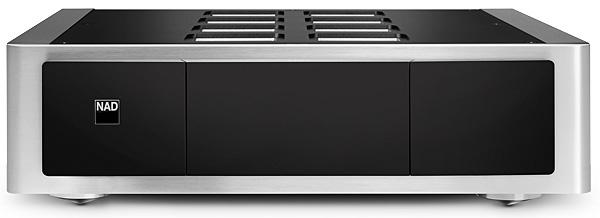NAD M23 Class D Power Amp

 Strip out the digital inputs, BluOS streaming module and preamp stage from NAD's M33 and we get a 'purist' implementation of Purifi's groundbreaking Eigentakt Class D tech
Strip out the digital inputs, BluOS streaming module and preamp stage from NAD's M33 and we get a 'purist' implementation of Purifi's groundbreaking Eigentakt Class D tech
Unlike the traffic on the motorway for which this stereo amplifier is definitely not named, Canadian manufacturer NAD is rolling along at pace. The M23 auditioned here, available in just a silver finish, is its latest amp to feature high-performance Purifi Eigentakt Class D technology, following in the footsteps of the £3999 M33 BluOS-capable integrated [HFN Aug '20], the seven-channel £4499 M28 power amp, and the more affordable £1749 C 298 stereo amp [HFN Oct '21]. That NAD should have chosen to adopt Eigentakt modules for a trio of models before upgrading its flagship two-channel Masters series power amp is perhaps something of a surprise. But it proves to have been worth waiting for.
In addition to the M23, NAD's Masters range – its flagship – covers (most) hi-fi and AV bases. Natural partners for this stereo amplifier are the M12 preamp/DAC [HFN Apr '15] and M50.2 music player, while multichannel options include the M17 V2 surround processor. Then there are two BluOS-equipped units: the aforementioned full-size M33 streaming DAC/amp, and the more compact M10 V2 streamer/amp, with large full-colour display.
Plant Anatomy
This last model features Ncore Class D amplification, but the M33 and M23 have effectively the same Purifi Eigentakt power plant – to the point that NAD suggests an M23 and M33 can be run together, each in bridged mode, for a system with dual mono amplification rated at 700W apiece. Used in stereo, rated power is still 200W/8ohm (380W/4ohm), likely making the M23 good for all but the most demanding of loudspeakers.
The price gap between the M23 and M33 is interesting. Spend an extra £600 to acquire the latter, and you get not only a typical roster of digital and analogue inputs, but also network audio playback and the option of 'room correction' via the Dirac Live platform. The £3399 asking price of the M23 therefore makes the M33 look like a bit of a bargain.

Of course, this power-only model will still be attractive to those already in ownership of a preamp or network DAC, but in this regard it then faces competition again from within the NAD stable. The C 298 also delivers well in excess of its rated 185W/8ohm output – putting the M23 in an almost awkward middle ground between it and the all-singing, all-dancing M33.
There are internal differences between NAD's two Eigentakt power amps of course, and then there's the matter of design and build. I described the C 298 as having 'the look of a black box recorder', while this Masters model is more akin to something you'd find in the First Class cabin. As power amplifiers go it's exceptionally pretty.
Happy Feet
NAD's brushed all-alloy casework is gorgeous, and I'm a fan of the two-tone design, which finds the front panel embellished by three black bevelled slabs. Even the 'magnetic iso-point' feet, which combine an integrated, pointed foot with a black magnetic 'shoe', have style.
Although a full-size model, the M23 weighs a paltry 9.7kg – a benefit of its refined Class D architecture and switchmode PSU. However, while Class D is often described as cool-running, this is in relation to the Death Valley operating temperatures of most tube amps and their Class A solid-state brethren. The M23 will automatically go into standby mode when you stop feeding it, but still warrants an installation with breathing room for its top-plate ventilation panels, and shouldn't be tucked into a closed cabinet, no matter how much its 133mm height makes that possible.
Orange Juice
Living with this amp is hassle-free, and setup might take you just a matter of minutes – choose between an unbalanced RCA or balanced XLR connection to your preamp, connect speakers to the 4mm binding posts, plug into the mains, flick the rear-panel power switch on, and you're good to go. Well, almost. In this state the square NAD logo on the front panel will be illuminated orange, meaning it's in standby mode. You'll then either need to wake it by playing some music (both the XLR and RCA inputs are 'auto-sensing') or press the small power/standby button almost hidden at the front of the M23's top panel. The NAD logo will then glow white. If you notice it glowing red, that's because it's gone into 'protect mode' and should be, says NAD, unplugged and checked for blocked ventilation or shorted speaker wires.























































